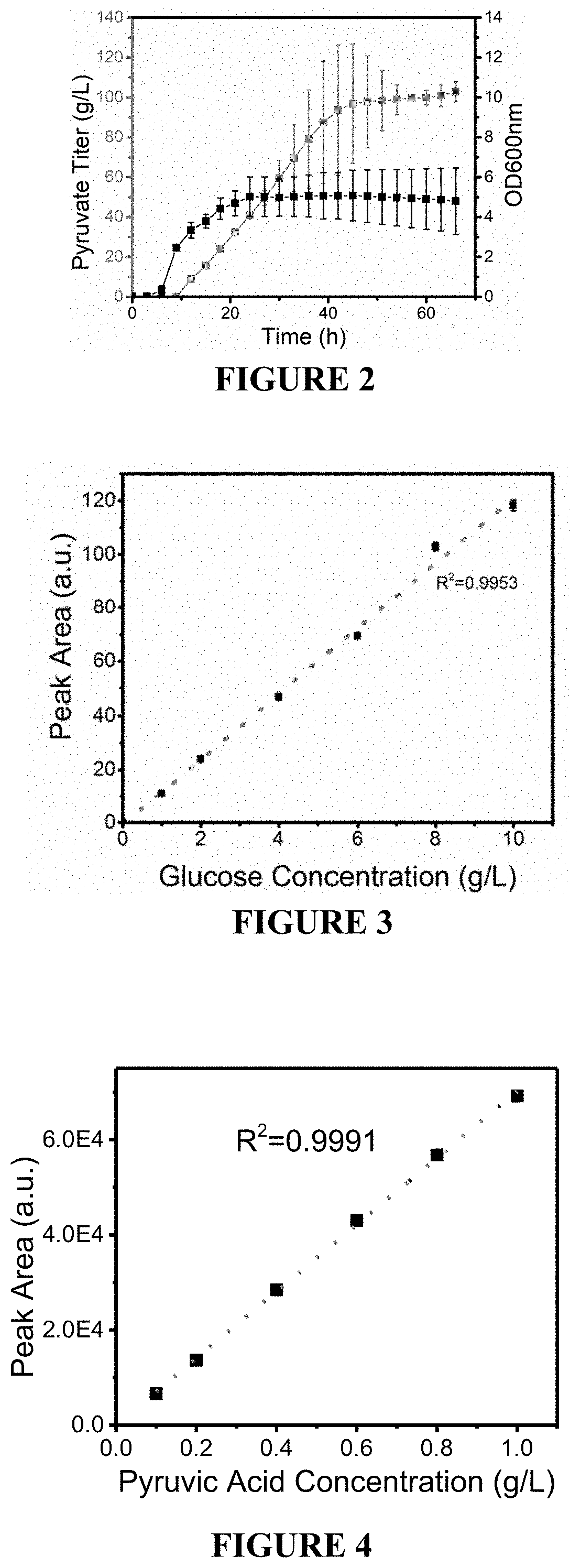Compositions and methods for the production of pyruvic acid and related products using dynamic metabolic control
a metabolic control and composition technology, applied in the direction of acyltransferases, enzymology, transferases, etc., can solve the problems of strains unexpectedly producing high rates of pyruvic acid through alternative pathways, and achieve the effects of improving pyruvate production, reducing or eliminating flux, and improving pyruvate production
- Summary
- Abstract
- Description
- Claims
- Application Information
AI Technical Summary
Benefits of technology
Problems solved by technology
Method used
Image
Examples
example 3
ion of Pyruvic Acid and Salts Thereof from Fermentation Broth
[0082]There are several well known methods for the purification of pyruvic acid and or its salts from aqueous broth. First broth may be clarified (removal of cells) by either centrifugation or filtration, such as ultrafiltration. Following clarification additional purification may include ion exchange chromatography (U.S. Pat. No. 4,918,013), such as a weakly-basic anion-exchange resin, which adsorbs the pyruvate anion. After rinsing out contaminants, the pyruvate can be eluted with a strong mineral acid such as sulfuric or hydrochloric acid (Japanese patent H06345683A). Alternatively, pyruvate in its acid form can be extracted into ether, the ether removed by vacuum evaporation and subsequently crystalized by addition of a miscible liquid. (U.S. Pat. No. 3,993,543). Yet another alternative purification involves complex-formation extraction using Tri-n-octanylamine (TOA) as an extractant. (Ma, C. Q., Li, J. C., Qiu, J. H.,...
example 4
n of Pyruvate Salts
[0083]Salts of pyruvate can be produced from clarified broth by extraction into an organic ester solvent such as tributyl phosphate, and then removed by addition of base to produce the metal pyruvate salts, which can be back-extraction into aqueous solution. (Chinese patent CN1103331C). Specifically, the addition of sodium hydroxide would lead to production of sodium pyruvate, the addition of magnesium hydroxide would lead to production of magnesium pyruvate, the addition of potassium hydroxide would lead to production of potassium pyruvate, addition of calcium hydroxide would lead to production of calcium pyruvate, and the addition of alternative hydroxides would lead to production of additional salts of pyruvate.
example 5
n of Pyruvic Acid to Pyruvic Acid Esters
[0084]Pyruvic acid, once produced, may be converted to the corresponding ester by reaction with an alcohol. For example, the addition of methanol to a mixture of pyruvic acid in the presence of an acid catalyst will result in the production of methyl pyruvate. As another example, the addition of ethanol to a mixture of pyruvic acid in the presence of an acid catalyst will result in the production of ethyl pyruvate. For example, Japanese Patent JPH1180088A teaches a method for the production of ethyl pyruvate by adding ethanol to pyruvic acid and heating in the presence of an acid catalyst. Since water reduces the yield of the reaction, 1,2-dichloroethane is added to enhance water removal. One skilled in the art may conduct this reaction with any alcohol and suitable catalyst to produce pyruvic acid esters
[0085]Esters of pyruvate may include for example polyol-pyruvate esters, pyruvate thioesters, glycerol-pyruvate esters or dihydroxyacetone-py...
PUM
| Property | Measurement | Unit |
|---|---|---|
| temperature | aaaaa | aaaaa |
| temperature | aaaaa | aaaaa |
| pH | aaaaa | aaaaa |
Abstract
Description
Claims
Application Information
 Login to View More
Login to View More - R&D
- Intellectual Property
- Life Sciences
- Materials
- Tech Scout
- Unparalleled Data Quality
- Higher Quality Content
- 60% Fewer Hallucinations
Browse by: Latest US Patents, China's latest patents, Technical Efficacy Thesaurus, Application Domain, Technology Topic, Popular Technical Reports.
© 2025 PatSnap. All rights reserved.Legal|Privacy policy|Modern Slavery Act Transparency Statement|Sitemap|About US| Contact US: help@patsnap.com


